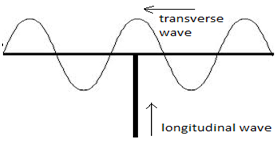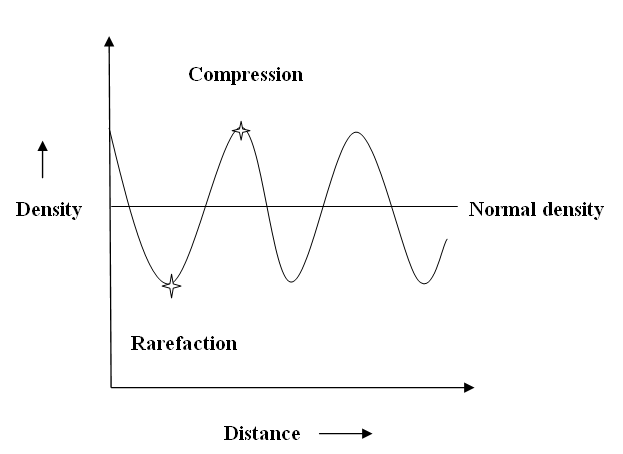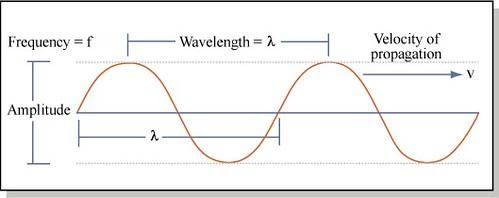Longitudinal Waves - Examples, Diagram, FAQs
Longitudinal waves belong to a class of mechanical waves, wherein particle displacement takes place in the same direction as the propagating wave. These waves move through compression and expansion as seen in the case of air, liquids, and even solids. These types of waves include sound waves which therefore are important in several natural and technological applications.
Define Longitudinal Wave
Waves can be classified into two types based on the direction of particles relative to the direction of the wave travel. They are transverse wave and longitudinal wave
The wave illustration of the two types of waves can be observed in the figure below.

Figure 1 Wave illustration of longitudinal and transverse waves
A wave consisting of a periodic vibration travelling in the same direction as the direction that the wave travels is called a longitudinal wave. From the above figure, the longitudinal wave is a wave in which particle displacement is parallel to the direction of wave propagation.
A wave in which the particle displacement is perpendicular to the direction of wave propagation is called a transverse wave.
Also, read
- NCERT Notes For All Subjects
- NCERT Exemplar Solutions for All Subjects
- NCERT Solutions for All Subjects
What is Longitudinal Vibration?
If the direction of the particles present in the shaft moves parallel to the axis of the shaft then it is called longitudinal vibration.
Explain Longitudinal Waves With Diagrams
In Figure 2, a longitudinal wave in the air is represented graphically. The longitudinal wave image below is a graph of distance from the source versus the density of air. Particles are denser at a particular region on the curve. It is called the compression region and it is present on the top of the curve. The region where particles are less crowded is called rarefaction. It is present at the bottom of the curve. In the compression region, particles are close to each other while they part away in rarefaction. Peaks represent maximum compression and rarefaction.

Figure 2 A longitudinal wave in the air
The Velocity of Longitudinal Wave
Longitudinal waves transmit through media with some velocities. The velocity of the wave depends on the elasticity and density of the substance.
In solids, the velocity of a longitudinal wave is given by,
$v=\sqrt{\frac{E}{\rho}}$
Here, E is Young’s modulus and ρ is the density of the substance.
In liquids, the velocity of a longitudinal wave is given by,
$v=\sqrt{\frac{B}{\rho}}$
Here, B is the bulk modulus and ρ is the density of the fluid.
Related Topics |
Examples of Longitudinal Waves
The longitudinal wave includes examples such as sound waves, seismic P-waves, ultrasound waves, etc.
The Wavelength of Longitudinal Wave
The distance between two successive compressions or between two successive rarefactions is called the wavelength of a longitudinal wave. It estimates the size of waves.

Figure 3 Sound wave
The above figure represents a sound wave which is also a longitudinal wave. The wavelength, amplitude, and velocity of the longitudinal wave are shown in the diagram.
Amplitude: When the wave compresses particles in the medium, the distance between those particles is called the amplitude of the wave. It can also be stated as the distance between the equilibrium position of the medium and the compression or rarefaction. Waves produced by greater energy of disturbance produce greater amplitude.
Frequency: Frequency is the number of wavelengths per second. Frequency remains constant regardless of the change in speed.
Sound Wave
If the particles are denser at a particular region in the sound wave, then it is compression in the sound wave. If those particles are separated then it is called rarefaction in the sound wave.
The motion of a sound component is measured from its equilibrium position as it produces sound waves. The distance measured is called displacement in a sound wave. The displacement and pressure in a sound wave are interrelated. Pressure in a sound wave is either maximum or minimum when its displacement is zero. If the neighbouring particles are nearer to the point then maximum pressure is observed. So, minimum pressure is observed when neighbouring particles are away from the point.
Difference Between Longitudinal Wave and Transverse Wave
Longitudinal and transverse waves are differed by the following:
Longitudinal waves | Transverse waves |
A longitudinal wave is a wave in which particle displacement is parallel to the direction of wave propagation. | A transverse wave is a wave in which the particle displacement is perpendicular to the direction of wave propagation. |
| The graph of distance versus density represents a longitudinal wave. | The Displacement-distance graph represents the transverse wave. |
| Longitudinal waves have compression and rarefaction. | The transverse wave has a crest and trough. |
| Longitudinal waves travel through any media. | Only through solid and liquid surface transverse wave travel. |
| Sound waves, ultrasound waves, tsunami waves, and seismic P waves are some of the examples of longitudinal waves. | Examples of transverse waves are the vibration of the guitar string, seismic S-waves, electromagnetic waves, etc. |
Frequently Asked Questions (FAQs)
Longitudinal refers to the length or lengthwise dimension of a quantity.
In a longitudinal wave, the distance between two consecutive waves is called the wavelength of the wave.
Longitudinal wave has a speed of about 5 miles per second.
Tsunami waves, earthquakes, vibrations caused by thunder are some of the daily life examples of longitudinal waves.
It travels in the direction parallel to the direction of motion of the wave.
A sound wave is a longitudinal wave as the particles in the medium propagate parallel to the direction of wave motion.
The maximum displacement of a particle perpendicular to the wave in a transverse wave is called crest while the region where particles are more crowded in a longitudinal wave is called compression.
Energy is transmitted during the propagation of a longitudinal wave through a medium.
Longitudinal waves can travel through any media such as solids, liquids, and gas.
Sound is a longitudinal wave.